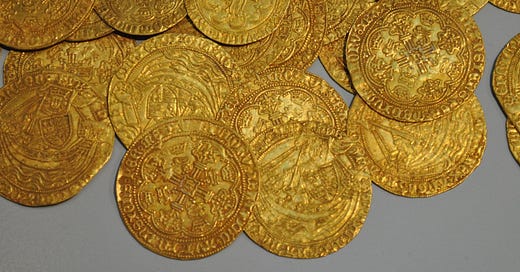TV Review: 30 Coins Season 1
Tags: Horror, 30 Coins, Possession, Demons, Apocrypha
We already wrote about our first impressions of Spanish horror streaming series 30 Coins after watching the first 8 episodes. And now that we’ve watched the remaining 5, we’re going to review Season 1. Warning: SPOILERS.
Most of the series takes place in the village of Pedrazia, where Elena, the local veterinarian, Paco, the mayor, and Father Manuel deal with strange events caused by an ancient shady cult, the Cainitas, that has infiltrated the Catholic Church. Their goal? To get one of the infamous 30 coins given to Judas, which ended up in Manuel’s possession during a botched exorcism. They can create monsters and mess with people’s minds from afar. The series occasionally leaves the village to go to the Vatican, Paris, and Syria, but nowhere is truly safe, and it doesn’t take long for things to get bloody and crazy.
BLOODY AND ORIGINAL
The first episode makes it clear what the audience can expect from this series: weirdness, gore, and Biblical references. 30 Coins doesn’t shy away from the crazy or the violence, and feeds viewers a steady stream of both. So, you get, a human-looking baby coming out of a cow, several stabbings, a teenage girl slicing her face, pig heads and various skinned animals nailed on doors and hanging on windows, monstrous spider-like creatures, someone being squeezed by a tentacle until they’re cut in half with all the messiness that entails, and more. The magic ranges from the more elegant - the mirrors - to the dirtier - the old woman’s more woods witch approach. There are also the predictable shocking revelations about Christianity - suppressed gospels, miracles as magical spells. And in the midst of all this chaos, the main trio of Manuel, Elena, and Paco do their best to survive and thwart the bad guys plans. There’s even some humour thanks to Paco’s interactions with both Elena, whom he falls for, and his wife, Merche. The series did a good job bringing Pedrazia to life as your typical village where there are no secrets, and people still act reverentially towards the local nobleman, Roque. You also get Laguna, the local cop, who moved there because it was quiet, and Antonio, who’s dismissed as the village idiot but actually knows about the supernatural plot. Outside the village, there’s Fabio, whom Manuel met in exorcist class and has become not only a powerful Cardinal, but also the leader of the Cainitas, and the mysterious Angelo, who claims to be the Devil, and is helping the cult. The series rarely gives its characters room to breath, and when it does, like Elena’s steamy interlude with Roque in Paris, it all tends to end in a brutal fashion. As for the dispensing of information, between Episodes 3 and 5, the audience learns who the villains, how Manuel is connected to them, and what they’ve been doing in the Vatican. In the end, everyone converges on Pedrazas and things of course get predictably crazy and bloody. So far, we’ve been pretty positive, however, we did have some issues. Sorry.
TALK TO EACH OTHER, DAMMIT!
Elena complains several times about having to keep quiet about all the crazy stuff she’s seen. Yet, she doesn’t actually talk about it to Paco or Manuel. They don’t talk much about it either, except to freak out about it or provide some exposition. We expected the trio to get together to theorize about what the hell was going on, but they never did. We don’t even know whether Manuel told them about what Fabio showed him in Rome, or how long the 3 had been hiding since Angelo took control of the villagers and they started preparing the coming of the Cainitas to anoint Fabio as their new Pope. Apparently it was long enough for Elena to get over Roque’s death and start making out with Paco, but that’s all.
LOVE QUADRANGLE
We’re no fans of love triangles, or of jealousy as motivation, especially for female characters, so we weren’t exactly happy about the development of Elena/Paco/Merche. Like we wrote in the previous post, we would’ve preferred if Paco and Elena had remained friends, but of course they didn’t. That the series added Elena/Roque and the move to Paco/Elena felt pretty abrupt after his death, didn’t help. Nor did the fact that we couldn’t quite understand why both she and Merche were so attached to Paco. Yes, Merche married him, but it was hard to take their relationship too seriously when it was used for comic relief and he ended up choosing Elena. Merche’s subsequent descent into if not villainy, at least very morally grey territory, felt rushed and was of course dependent on how believable were her strong feelings for Paco. Still, at least she ended the season in a very interesting situation, and honestly, we’re more curious about where the series is taking the character than about Paco or Elena’s future.
WHAT’S THE DEAL WITH ANTONIO?
On our previous post, we mentioned how his loyalties were unclear, and these next 5 episodes didn’t help clarify that. So, while he hears the voices from the Cainitas and helps Angelo circle the village with black goo made from the blood of the unborn, thus trapping everyone inside, he also warns everyone about him and accuses him of being the Devil. He keeps quiet about Manuel’s secret weapons’ stash, gives Paco advice, and helps Laguna escape. But, on the other hand, he seems to push Merche to go to the witch with the talk about Elena’s husband’s return. Yeah, we got nothing. Weirdly, only Manuel in the beginning and later the 2 agents sent by the Secretary of State of Security try to talk to him and find out what he knows.
THINGS GET BIBLICAL
Up until Episode 5, 30 Coins gives the audience tantalizing glimpses of Church secrets, and introduces an ancient cult, in league with the Devil himself for power and forbidden knowledge, that’s about to take over the Vatican. And what better holy book for this cult than The Gospel of Judas? Later we find out that the coins themselves have also been wreaking havoc on their own, namely Napoleon’s failed invasion of Russia and the Holocaust, which only happened because Napoleon and Hitler were looking for more coins. However, all this remains incredibly superficial, and in one case, doesn’t even make sense.
First, the coins’ role in 2 wars. The information is shared by Antonio in the season finale, and nothing else is said about it. This is something that should’ve come up already, as it would’ve made the danger of the coins much clearer. Then again, Napoleon and Hitler just wanted more coins. Do they have an addictive effect? Were they part of the cult, too? As for the Vatican secrets, we don’t get more than what Manuel is shown in Episode 5, and since his old friend Sandro tells Fabio that it’s all lies, it could even be all a trick from the Devil to lure in more followers. Our problem isn’t that the series didn’t bother clarifying that - it could’ve just been left for the next season - but that the secrets that throw the Church’s version of Christianity into question don’t go beyond stating that the miracles were just magic and there’s a Gospel of Jesus. Okay, but what does it say? We wouldn’t have a problem with not knowing if the characters had talked about it and wondered what was in it, but there’s no other mention of it. Honestly, 30 Coins doesn’t seem interested in upending the Church or the standard version of Christianity, and we don’t think that’s going to change.
And now, The Gospel of Judas. Great name, right? Even better, it’s real! And of course, Manuel’s description of it showing Judas’ betrayal as part of the plan and how the cult saw that as a sign that doing evil is part of the divine plan seemed fitting for such a text. However, there’s one itty-bitty problem: that’s not what The Gospel of Judas is about. Yes, it does say that Judas’ betrayal was part of the divine plan, but it’s part of the Sethian tradition, which had a very different view of God, the origins of Jesus, and divine hierarchy than the official doctrine. It’s also missing some bits, but even if we’re meant to believe that the Cainitas have the full scroll, it’s still part of a larger belief system and not something that could be used on its own. An even bigger issue is that not only is Jesus not the God that the Church worships, but also that the crucifixion is seen very differently. Instead of crying over it, the Sethians laughed at it, as they saw the efforts of men to kill Jesus as ridiculous. Jesus didn’t suffer on the cross - his spirit simply left the body it had taken residence in. In The Gospel of Judas, Jesus tells Judas that he ‘will sacrifice the man who bears me’, which doesn’t quite sound like saying Judas is going to kill him. This view of the crucifixion is at odds with the notion that the Cainitas are looking for objects that made God suffer. We even googled to see if there was another Gospel of Judas, but there isn’t. This was such a weird choice. All the series had to do was not link its Gospel of Judas to the real thing and make up its own. Instead, the audience sees Elena and Paco googling it and finding information about the apocrypha that Manuel doesn’t deny. And if this is supposed to be a different Gospel of Judas, the series really should’ve made that clearer. Honestly, it really feels as if the people behind this just looked at the title and thought it would be cool to use a real scripture.
VERDICT
Throughout its 8 episodes, the first season of 30 Coins takes its audience on an enjoyable wild ride (the exception being Manuel’s time in Syria, which took way too long and featured some tired dialogue about faith). However, the lore is superficial and some characters’ relationships are poorly developed. Maybe some of the things that were left unexplained will be looked into in the second season, but we wouldn’t be surprised if most of them were ignored. Still, it’s an entertaining show that feels fresh and original.
By The Snarky Cats of Ulthar
More 30 Coins
Now Watching: 30 Coins
We finally started watching Spanish horror streaming series 30 Coins (2020) and judging by the first 3 episodes, it’s going to be a wild ride. Warning: SPOILERS.





